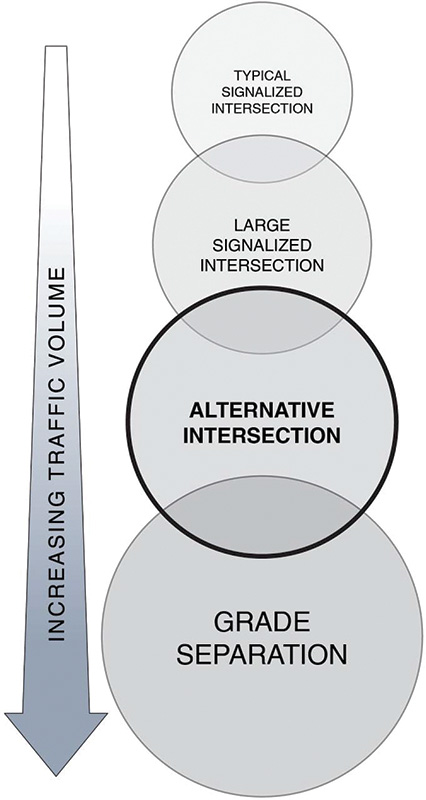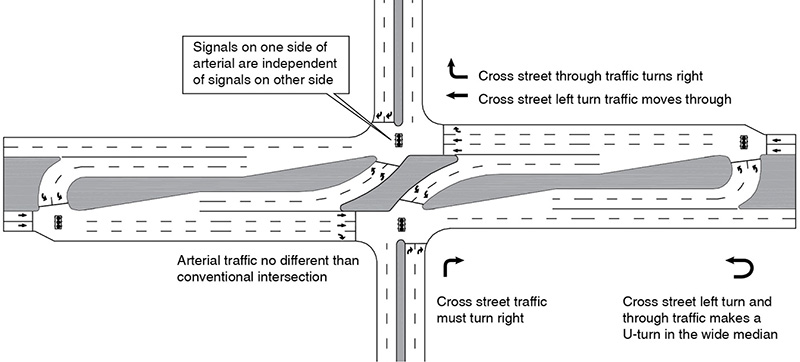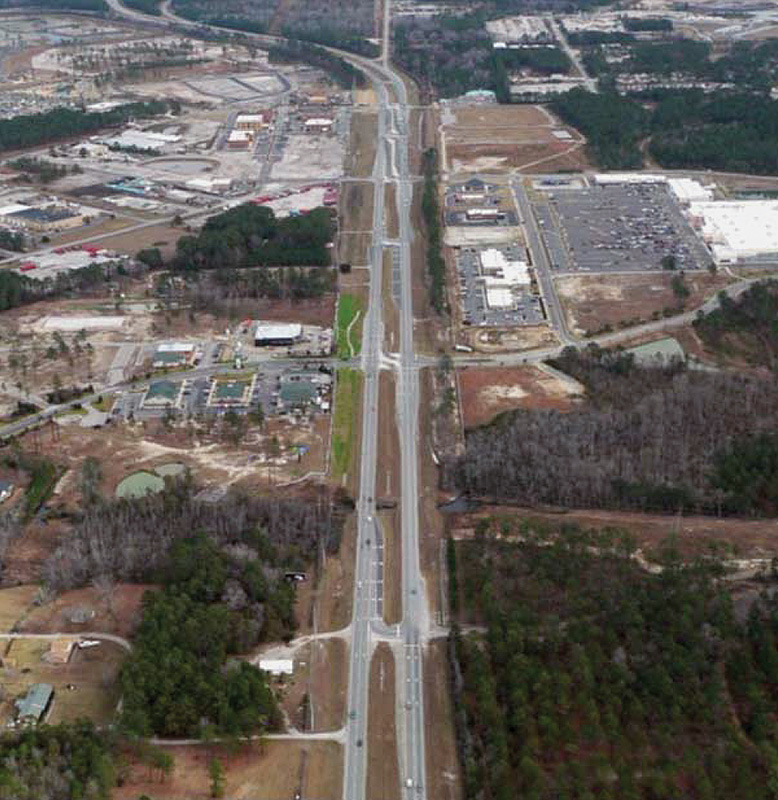Transportation Systems Management and Operations and Performance Based Practical Design Case Study 3: Demonstrating Performance-Based Practical Design through Alternative Intersections
Printable Version [PDF, 1 MB]
U.S. Department of Transportation Publication #: FHWA HOP-16-039 September 2016 Purpose of the Transportation Systems Management and Operations Performance-Based Practical Design Case Study Series and Summary of Case Study 3As states and local agencies become increasingly challenged with addressing their system performance, mobility, and safety needs in the current era of financial limitations, Federal Highway Administration (FHWA) is providing guidance, delivering technical assistance, and sharing resources related to performance-based practical design (PBPD; source: FHWA). The FHWA Office of Operations is supporting the overall Agency PBPD effort by highlighting the role Transportation Systems Management and Operations (TSMO) alternatives and analysis tools can play in supporting PBPD. To illustrate the range of TSMO strategies and tools and how they can be applied by transportation planners and designers in a PBPD context, five brief case studies have been developed. This Case Study 3 illustrates how a PBDP approach can be applied by using alternative intersections. Alternative intersections can serve more vehicles than similarly sized, conventional signalized intersections and often also offer safety benefits. This case study specifically highlights one alternative intersection form — restricted crossing U-turn (RCUT). Other case studies in this series include high-occupancy toll (HOT) lanes implementation, urban freeway reconstruction and modernization, regional performance-based planning, and PBPD during active traffic management (ATM) design and implementation. Case Study BackgroundGrade separation is the traditional tool used by transportation planners and engineers to relieve congestion and increase capacity at large, high-volume signalized intersections. However, grade separation is increasingly challenging to implement due to developed land and lack of right-of-way surrounding signalized intersections, its high cost, and its incompatibility with more urban land uses. Alternative intersections typically relocate some through or turning movements from a main intersection to nearby smaller intersections, thus reducing the number of signal phases at the main intersection. Figure 1 shows a general relationship between intersection types and traffic volumes. The most common alternative intersection forms include the RCUT, displaced left-turn (DLT), and median U-turn (MUT). RCUT intersections may be signalized or unsignalized. Signalized RCUTs — also known as superstreet intersections — are typically implemented as an operational improvement and are the focus of this case study. Unsignalized RCUTs — also known as J-turns — are typically implemented as a safety improvement in rural, lower volume areas. Figure 2 shows a signalized RCUT. This case study is focused on signalized RCUTs, because they strongly illustrate the relationship between design elements and operational effects. Corridor and System Needs and ObjectivesPBPD strengthens the emphasis on planning-level corridor or system performance needs and objectives when planning, scoping, and developing individual projects.
Figure 1. Graphic. Relationship between Total Entering Colume and Intersection Type The purpose and need of arterial improvement projects often include improving safety, mobility, or accessibility. Arterial crashes are often concentrated at intersections, where the most conflict points are present. If signal timing is optimized and intersections have an appropriate number of turning lanes, then conventional operational solutions, such as widening or grade separation, likely will be costly or have undesirable impacts. The RCUT design and resulting operation address both of these common project needs. RCUTs eliminate or reduce intersection conflict points and redirect movements that typically cross both directions of the major street. They also reduce signal phases. More so than other alternative intersections, RCUTs are corridor treatments and create unique signal timing and progression opportunities when used in series. As shown in Figure 2, the minor street through and left-turn movements are redirected to U-turn crossovers, and no movements cross both directions of the major street at the same time. This effectively creates a pair of one-way streets with independent signal timing. A series of RCUT intersections enables corridor-level improvements, rather than spot improvements at individual intersections. Performance ImprovementsPBPD focuses on performance improvements that benefit both project and system needs.At the planning level, FHWA's CAP-X Spreadsheet can be used to assess RCUT feasibility. The next edition of the Highway Construction Manual will include a procedure for RCUT intersections, enabling an objective operational comparison to traditional signalized intersections. RCUTs eliminate 18 of 32 conflict points at a typical four-leg intersection, and studies of unsignalized RCUTs have identified a crash reduction of nearly 50 percent. These tools and generalized findings enable performance-based selection of corridor alternatives.
In 2010, three signals on a 3.5-mile section of US 281 north of San Antonio, Texas, were converted from conventional designs to RCUTs. US 281 in this area
is a four-lane divided highway with a 60-mile per hour posted speed limit. After RCUTs were installed, southbound travel times in the a.m. peak decreased
from 23.3 to 13.9 minutes, and northbound travel times in the p.m. peak decreased from 19.2 minutes to 12.7 minutes.

Figure 2. Graphic. Signalized Restricted Crossing U-Turn Intersection Greater Return on InvestmentsBy scrutinizing each project scope element relative to value, need, and urgency, a PBPD approach seeks a greater return on infrastructure investments.The low cost of RCUTs enables improvements to be made to an entire corridor for the same or lower cost than a traditional improvement — such as an at-grade intersection or parallel roadway to relieve volume — at one location.
North Carolina Department of Transportation (DOT) has constructed RCUT corridors in lieu of freeways, significantly accelerating project implementation at
reduced cost. In 2006, North Carolina DOT converted three conventional signalized intersections to RCUTs on a 0.6-mile segment (Figure 3) of US 17 near
Wilmington for $2 million. The RCUTs are the first at-grade intersections after a freeway section of US 17 connecting to downtown Wilmington and help
prevent a bottleneck at the end of the freeway. The cost of grade separating these intersections would have been an order of magnitude higher.

Figure 3. Photograph. US 17 Restricted Crossing U Turn Corridor Design Standards and Regulatory RequirementsPBPD can be implemented within the Federal-aid Highway Program regulatory environment utilizing existing flexibility. PBPD does not eliminate, modify, or compromise existing design standards or regulatory requirements.Nothing is inherent in the design of an RCUT that requires substandard design features or design exceptions. Design of median U-turn crossovers is guided by specific recommendations in American Association of State Highway and Transportation Officials' "Green Book." Performance-Based Practical DesignPBPD encourages the evaluation of the performance impacts of highway design decisions relative to the cost of providing various design features. PBPD can be articulated as modifying a traditional design approach from a "top-down," standards-first approach to a "design-up" approach where transportation decision- makers exercise engineering judgment to build upon the improvements from existing conditions to meet both project and system objectives. PBPD uses appropriate performance-analysis tools and considers both short- and long-term project and system goals while addressing project purpose and need. Following a PBPD approach can use scarce resources more efficiently, so that more improvements can be made, increasing overall transportation system performance to exceed that of individual project based decisions. Following are notable PBPD attributes:
ContactsJim Hunt
Mark Doctor
|
|
United States Department of Transportation - Federal Highway Administration |
||